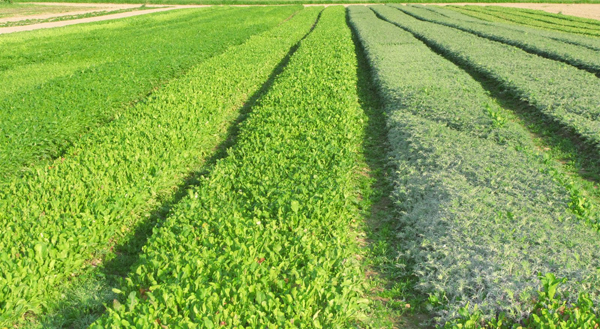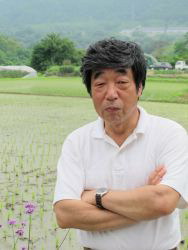First astronaut became organic farmer
 The first Japanese astronaut to travel to space in 1990 on the then-Soviet spacecraft Soyuz, journalist Toyohiro Akiyama, had since moved to the Fukushima Prefecture city of Tamura to become an organic farmer.
The first Japanese astronaut to travel to space in 1990 on the then-Soviet spacecraft Soyuz, journalist Toyohiro Akiyama, had since moved to the Fukushima Prefecture city of Tamura to become an organic farmer.
Since the accident at the Fukushima No. 1 Nuclear Power Plant, however, the 69-year-old Akiyama has been staying in the Gunma Prefectural city of Fujioka, where he greeted me at the bus station with a deep tan, wearing rubber boots. He seemed to be perfectly comfortable in the role of farmer, both inside and out.
I was led down the Kanna River that borders Gunma and Saitama prefectures to a 600-square-meter rice paddy that Akiyama had rented from an acquaintance of his who also engages in organic farming. Akiyama planted rice seedlings here in early July.
“In Fukushima, I used to plant rice around May 20 or so, but it took a long time before water temperatures went up,” Akiyama says. “I’m surprised by how quickly the rice grows here.”
In a greenhouse, Akiyama grows vegetables such as asparagus, kabocha squash and peppers. Akiyama seems to be settled into his new home, now that he’s finally “returned” to his life as a farmer.
On Dec. 2, 1990, Akiyama, then a reporter at Tokyo Broadcasting System Television (TBS), boarded the Soviet spacecraft Soyuz at the Kazakh launching facility Baikonur Cosmodrome. His first words from space were: “Are we live?” in response to a live call from a Tokyo television studio.
He later went on to head the broadcaster’s international news center but quit the company in 1995, claiming that he couldn’t tolerate being in a management position away from the action on the ground. Moving to the town of Takine — now merged with neighboring towns to become the city of Tamura — in Fukushima Prefecture, he began organic farming with the aim of becoming self-sufficient. He continues to write, however, including a series in the monthly magazine Shizen to Ningen (Nature and human beings) about life in farming.
Akiyama bought a 10,000-square-meter plot of land at an elevation of 600 meters above sea level in the Abukuma Mountains. He began growing shiitake mushrooms, rice and vegetables. This year — what would’ve been his 16th year farming in Fukushima — he had planned to keep bees and try his hand at becoming self-sufficient in honey. Then the Great East Japan Earthquake struck.
“Since it had been 40 years since operations began at the Fukushima No. 1 Nuclear Power Plant, I’d guessed that its decommissioning process would begin right about this year,” Akiyama says. “I now know what an ill-advised assumption that had been.”
Akiyama’s home is located 32 kilometers from the nuclear power plant. By March 12, the day following the temblor, tsunami and ensuing nuclear disaster, residents of the Fukushima Prefecture town of Okuma, where the stricken plant is located, began pouring in to a gymnasium near his home. There were television reports of cesium being detected in the air, and when Akiyama stepped outside with a radiation detection device that he’d owned from before, the alarm went off. Feeling that his life was in danger, Akiyama evacuated to a lodging facility in the prefectural city of Koriyama. Realizing that it would take a while before the crisis was brought under control, Akiyama decided to stay with an acquaintance in the town of Onishi in Fujioka, Gunma Prefecture.
Asked what he thinks of the situation four months into his evacuation to a place that’s approximately 200 kilometers from the power plant, Akiyama says, “Unless we rid ourselves of the myth — or rather, it’s an ideology — if we do not rid ourselves of the ideology that we cannot be happy without economic growth, I don’t think we’ll be able to take away any lessons from the tragedy.”
 The one puzzle that Akiyama, who went through his college years in the wake of the 1960s student demonstrations, has tried to understand throughout his adult life is the modernization of Japan. The reason that he jumped into farming was because he wanted to experience the self-sufficient lifestyle that existed before the country modernized. Looking at the Earth from Space Station Mir, he says, reinforced the notion that in light of the environmental degradation that was taking place, it was time for him to take action.
The one puzzle that Akiyama, who went through his college years in the wake of the 1960s student demonstrations, has tried to understand throughout his adult life is the modernization of Japan. The reason that he jumped into farming was because he wanted to experience the self-sufficient lifestyle that existed before the country modernized. Looking at the Earth from Space Station Mir, he says, reinforced the notion that in light of the environmental degradation that was taking place, it was time for him to take action.
From the rapid economic growth era to the bubble period, post-war Japan has constantly pushed forward in pursuit of economic growth. “By the 1980s, the only demand we could expect was in the form of replacement purchases. Once things have been distributed to the entire population, there’s nothing left to do but stoke desire. As a result, we’ve been made to feel that we cannot go on without things that we actually don’t need.
“The expansion of IT into all areas of life is a part of that. Convenience became a mantra, without questioning whose happiness it achieved. Electrification became the equivalent of convenience, and energy — that is, nuclear energy — is an extension of that.
Akiyama got rid of his computer when he was 60, and until he became a “nuclear crisis refugee” several months ago, he didn’t own a cell phone. So how do we lead lives that don’t depend on economic growth?
“What the economy’s primary sector, like farming and fishing, has at its core is day-to-day life. It isn’t necessarily about seeking profit or expansion, and its basic goal is the maintenance of everyday life. I’d been able to live a decent life by growing shiitake, rice and vegetables. It’s not about swinging wildly between elation and disappointment because of how much eggplants are selling for at a given time. It’s about eating eggplant because I harvested it. There’s a good harvest some years, and other years, not so much,” he says.
“Corporations are finding their way into farming, too, but for them, profit is the objective. But year-by-year financial accounting just doesn’t make sense for the primary sector.”
Meanwhile, a nuclear crisis triggered by the March 11 earthquake and tsunami has yet to be brought under control. What’s next for Akiyama, who evacuated on his own accord from his home in Tamura, located just outside the 30-kilometer evacuation zone set by the government?
“I think that I may be able to return home once the reactor buildings are covered,” says Akiyama, adding, however, that because shiitake mushrooms — which used to bring him 1 million yen per year through direct sales — are believed to readily absorb radioactive cesium, he’ll have to hold off on that for decades.
“I’ll have to wait for about 30 years. By then, I’ll be 99 years-old. That’s how long cesium’s half-life is. Like the government says, radiation levels might not be at ‘levels that pose an immediate danger to health,’ but I won’t sell anything that I can’t confidently say is safe. Negative rumors (about the safety of certain foods) are a reflection of the public’s distrust toward the government. The public is wise not to buy products that they are told have radiation levels below the maximum permissible amount, when they aren’t being presented with hard data.”
Akiyama also voices anger, which may be what’s felt by many people from Fukushima. “My post-retirement has been totally ruined. I want to make a voodoo doll with straw when I harvest my rice plants this fall, give them names of those in the ‘nuclear power village’ (a tight web of academics and industry and government members promoting nuclear power), and strike nails through them.”
